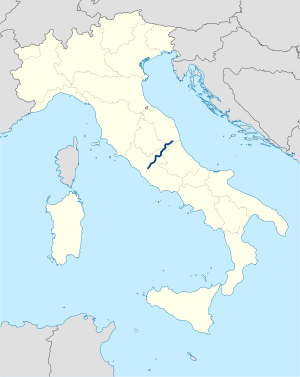Strada statale 4 Via Salaria
| State Highway 4 | ||||
|---|---|---|---|---|
| Strada statale 4 | ||||
| Salaria | ||||
 | ||||
| Route information | ||||
| Maintained by ANAS | ||||
| Length | 208.2 km (129.4 mi) reduced to 175 km since the Ascoli-Porto d'Ascoli trait was declassed to provincial road | |||
| Existed | 1928–present | |||
| Major junctions | ||||
| From | City centre of Rome | |||
| Tangenziale Est and GRA in Rome; Autostrada A1 at Settebagni and Passo Corese; SS 636 di Palombara at Borgo Quinzio; SS 79 Ternana and SS 578 Salto Cicolana in Rieti; SS 17 in Antrodoco; SS 471 di Leonessa at Posta; SS 260 Picente at Amatrice; SS 685 delle Tre Valli Umbre at Arquata del Tronto; Raccordo autostradale 11 and SS 81 Piceno Aprutina at Ascoli Piceno | ||||
| To | SS 16 Adriatica at Porto d'Ascoli | |||
| Location | ||||
| Country | Italy | |||
| Regions | Lazio, Marche | |||
| Highway system | ||||
| ||||
Strada statale 4 Via Salaria is an Italian state highway, linking Rome to the Adriatic sea passing through Rieti and Ascoli Piceno. Its route retraces that of the ancient Via Salaria roman road. It is a single carriageway highway for most of its route.
Route



Strada statale 4 Via Salaria starts just outside the Aurelian Walls of Rome, where for centuries Porta Salaria was located to let people enter the city. The initial stretch of SS 4 is more similar to an urban road than to an highway, as the area has now become densely populated and buildings have been raised by the roadside. After four kilometres SS4 meets Tangenziale Est di Roma and, from that point on, becomes a dual carriageway urban road, flanked by the Florence–Rome railway. In the Castel Giubileo neighborhood SS4 meets Grande Raccordo Anulare and returns a single carriageway highway, albeit reasonably wide. In Settebagni the SS4 meets Autostrada A1, to which runs parallel for a long stretch. In Passo Corese SS4 enters the Province of Rieti and meets once again with Autostrada A1, diverging from it; after reaching Osteria Nuova, the SS4 enters a narrow valley between the Sabine mountains. In San Giovanni Reatino SS4 returns a dual carriageway road, with the long "Colle Giardino" road tunnel at the end of which is Rieti, but shortly before Cittaducale the road returns a single carriageway and pretty narrow road. After reaching Cotilia and Antrodoco, SS4 enters the narrow "Gole del Velino" canyon, where the road becomes similar to a mountain road and climbs from 470 to 700 metres above sea level. In Posta, at the end of the canyon, a recently uprated stretch of the road begins, where tunnels and viaducts make the road smoother albeit still with a single carriageway. The road keeps going up, until reaching the Torrita Pass at around 1010 metres on the sea level, shortly before Amatrice. In Pescara del Tronto SS4 enters the region of Marche, and keeps descending until it reaches province capital Ascoli Piceno. From here the street continues towards the Adriatic sea, where it ends in a junction with SS 16 Adriatica and the Autostrada A14, but such trait has been recently declassed to provincial road, as it has been replaced by Raccordo autostradale 11, a more modern dual carriageway road.
Future interventions
Today SS4 is a busy road between Rieti and Passo Corese, as it is the main road link between Rieti and Rome; motorists use it to reach the Autostrada A1 in Passo Corese and continue towards Rome in the more modern road. In this trait SS4 has a single, albeit reasonably wide carriageway, which was constructed in the 1960s in place of an earlier, less smooth road.[1] For this reason, Italian Government plans to make SS4 a dual carriageway road between Rieti and Passo Corese, but around 1.5 billion euros are needed[2] and it is not known when funds will be granted.
Uprating of the trait from Cittaducale to Posta, where the carriageway is rather narrow and the road climbs up the Apennine mountains, is also planned to make the carriageway larger and less winding - even if the road will remain with a single carriageway. The first part of these road works started in 2005 on the Posta-Micigliano stretch[3] and are currently underway.
References
- ^ "Relazione di sintesi". Ministero dell'Ambiente. 21 June 2007. Retrieved 8 March 2016.
- ^ Camera dei deputati - Sistema Informativo Legge Opere Strategiche
- ^ "Via all'appalto del primo lotto della Salaria". Il Tempo, Rieti edition. 12 May 2005. Retrieved 17 March 2016.

